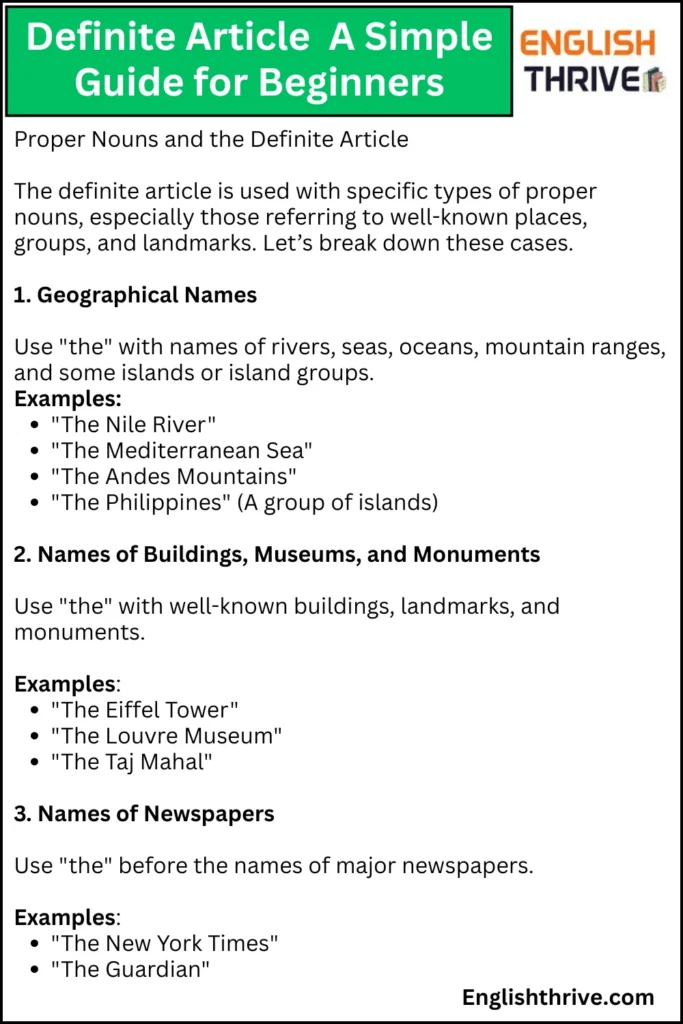In English grammar, one of the most frequently used words is “the.” This word, known as the definite article, plays a crucial role in the language. It is used to indicate a specific noun, one that both the speaker and the listener know. Whether you’re speaking or writing, knowing when and how to use the definite article is essential for clear and accurate communication. In this article, we will dive into the rules and usage of the definite article, its exceptions, and how to apply it in various situations.
Contents
ToggleWhat Is the Definite Article?
The word “the” is the only definite article in English. It is used before singular and plural nouns to indicate that the speaker is referring to a specific object, person, or thing that is known or identifiable by both the speaker and the listener.
For example:
“I saw the cat in the garden.”
“She went to the store.”
In these sentences, “the cat” and “the store” are specific nouns known to both the speaker and listener.
When to Use the Definite Article
General Rules for Using “The”
The definite article is used in a variety of situations. Here are some general rules that will help guide your understanding of when to use “the.”
1. When Something Has Already Been Mentioned
Use “the” when you are referring to something that has already been mentioned or is known to both the speaker and listener.
Examples:
“I bought a book yesterday. The book is on the table.”
“I went to a park. The park was very crowded.”
In these examples, the word “the” refers back to something already identified.
2. When There Is Only One of Something
Use “the” when referring to a unique item or something that there is only one of in a particular location.
Examples:
“Where is the sun?”
“He went to the moon.”
The definite article is used because both the speaker and listener know that there is only one sun or one moon.

3. When Referring to Specific People or Things
Use “the” to identify or define specific people or things.
Examples:
“The man who called you is waiting outside.”
“The red car is mine.”
Here, the speaker is referring to specific people or objects.
4. When Using Superlatives and Ordinal Numbers
The definite article is always used before superlative adjectives or ordinal numbers.
Examples:
“The tallest mountain is Mount Everest.”
“This is the first time I’ve seen that movie.”
5. When Referring to Groups or Classes
Use “the” when talking about a whole group of people or things, especially when talking about a class of people or objects.
Examples:
“The elderly need care.”
“The rich should pay higher taxes.”
In these cases, “the” refers to all people in a specific group.
When Not to Use “The”
While “the” is used in many situations, there are also specific cases where you should not use it. Let’s explore some common scenarios.
1. Names of Countries (with exceptions)
In general, we do not use “the” before the names of countries. However, there are some exceptions, which we’ll cover later.
Examples:
“I visited Japan last summer.” (Correct)
“I live in France.” (Correct)
But for some countries with plural names or those that include terms like “republic” or “kingdom,” “the” is used.
Examples:
“The United States”
“The United Kingdom”
2. Languages
We do not use “the” before the names of languages.
Examples:
“She speaks French.” (Correct)
“I am learning English.” (Correct)
3. Meals
We typically do not use “the” before meals unless the context is specific or refers to something particular.
Examples:
“I had breakfast at 8 a.m.” (Correct)
“I love lunch.” (Correct)
4. People’s Names
We do not use “the” before individual people’s names.
Examples:
“John is coming to the party.” (Correct)
“Mary is my boss.” (Correct)
However, “the” is used before family names when referring to the whole family.
Examples:
“The Smiths are coming over tonight.”
“The Browns have invited us for dinner.”
5. Possessive Nouns
Do not use “the” after possessive nouns.
Examples:
“This is Peter’s car.” (Correct)
“That is Sarah’s book.” (Correct)
Proper Nouns and the Definite Article
The definite article is used with specific types of proper nouns, especially those referring to well-known places, groups, and landmarks. Let’s break down these cases.
1. Geographical Names
Use “the” with names of rivers, seas, oceans, mountain ranges, and some islands or island groups.
Examples:
“The Nile River”
“The Mediterranean Sea”
“The Andes Mountains”
“The Philippines” (A group of islands)
2. Names of Buildings, Museums, and Monuments
Use “the” with well-known buildings, landmarks, and monuments.
Examples:
“The Eiffel Tower”
“The Louvre Museum”
“The Taj Mahal”
3. Names of Newspapers
Use “the” before the names of major newspapers.
Examples:
“The New York Times”
“The Guardian”
4. Organizations
Use “the” with the names of organizations, especially those that are formal and established.
Examples:
“The United Nations”
“The Red Cross”
What About Proper Nouns Without the Definite Article?
While certain proper nouns require “the”, others do not, including:
Individual people’s names (e.g., John, Mary)
Most city and town names (e.g., London, Paris)
Street names (e.g., Oxford Street, Main Street)
Airport names (e.g., Heathrow Airport, JFK Airport)
Some mountain names (e.g., Mount Everest, Mount Kilimanjaro)
In these cases, no definite article is used.
Capitalization of “The” in Proper Nouns
The word “the” is typically capitalized when it begins a sentence or when it’s part of a title. However, it is not capitalized in the middle of a sentence unless it’s at the start of a proper noun.
Examples:
“The United States is a powerful country.”
“I visited the Eiffel Tower last summer.”
But if “the” appears within the title of a book or movie, it is capitalized.
Example:
“The Great Gatsby”
“The Lord of the Rings”
Definite Article with Historical and Cultural Terms
“The” is also used with terms referring to historical periods, certain cultural terms, and well-defined eras.
Examples:
“The Renaissance”
“The Industrial Revolution”
“The Middle Ages”
“The Cold War”
These terms describe significant periods or movements in history, and “the” helps to specify them as particular, well-known events.
Common Mistakes to Avoid When Using the Definite Article
While the rules for using the definite article are straightforward, it’s easy to make mistakes. Here are some common errors that people often make when using “the”, and how you can avoid them.
1. Using “The” Before Uncountable Nouns
Uncountable nouns refer to things that cannot be counted individually, like liquids, air, or concepts. We do not use “the” with most uncountable nouns unless we’re talking about something specific or known.
Common Mistake:
“The information is valuable.”
Correction:
“Information is valuable.” (No article needed unless referring to specific information)
Examples of Uncountable Nouns:
water
air
advice
money
time
You only use “the” with these nouns when you’re referring to something specific that both the speaker and listener are aware of.
Example:
“I need the water from the fridge.” (Refers to specific water)
2. Overusing “The” with Proper Nouns
As we’ve discussed, certain proper nouns require “the” while others don’t. One common mistake is overusing “the” with proper nouns that do not need it.
Common Mistake:
“The New York is a beautiful city.”
Correction:
“New York is a beautiful city.”
Examples of proper nouns that do not require “the”:
Names of countries (e.g., Canada, India)
Names of cities (e.g., London, Paris)
Names of streets (e.g., Oxford Street)
3. Using “The” Before Plural Nouns When Not Necessary
Sometimes, we use “the” before plural nouns when it’s not required. You should avoid using “the” when speaking about general or non-specific items.
Common Mistake:
“I love the cats.”
Correction:
“I love cats.” (No article is needed because it’s a general statement)
Use “the” with plural nouns only when you’re referring to specific groups of things that are known or have been previously mentioned.
Example:
“I met the cats in the backyard.” (Refers to specific cats)
4. Confusing “The” with Indefinite Articles
The indefinite articles “a” and “an” are used to refer to non-specific items. However, some people mistakenly use “the” when they should use “a” or “an”.
Common Mistake:
“I saw the cat in the park.”
Correction:
“I saw a cat in the park.” (Refers to any cat, not a specific one)
Use “a” or “an” when you’re talking about something for the first time or when the specific item is unknown to both the speaker and listener.
5. Omitting “The” with Superlatives or Ordinal Numbers
When using superlative adjectives or ordinal numbers, always use “the”.
Common Mistake:
“She is best in the class.”
Correction:
“She is the best in the class.”
Similarly, remember to use “the” with ordinal numbers:
Example:
“This is the first time I’ve been here.”
How to Practice Using “The” in English
Now that we have covered the rules and common mistakes with the definite article, it’s time to put your knowledge into practice. Here are some tips to help you improve your understanding and use of “the” in daily conversation and writing.
1. Read English Texts with a Focus on Articles
Reading is one of the best ways to internalize grammar rules. As you read books, articles, and other materials, pay close attention to how “the” is used in different contexts. Try to identify which types of nouns are preceded by “the” and why.
2. Practice Speaking with Native Speakers
Speaking practice is essential for reinforcing what you’ve learned. Try engaging in conversations with native English speakers, and pay attention to how they use “the” in their responses. If you’re unsure about the usage, don’t hesitate to ask for clarification.
3. Complete Grammar Exercises
There are many online resources and grammar books that offer exercises specifically focused on the definite article. Doing these exercises will help you identify when to use “the” correctly and when not to.
4. Write Regularly
Writing helps reinforce grammar rules, especially when it comes to articles. Try writing short paragraphs or essays while consciously focusing on using “the” in the right contexts. Afterward, review your writing to check for mistakes.
FAQs On Definite Article
What is a definite article and example?
A definite article is the word “the.” It is used to refer to a specific person, place, or thing.
Example: The sun rises in the east.
Here, “the” shows that we are talking about one specific sun.
What are the 10 examples of articles?
Articles are small but important words in English grammar. The three articles are a, an, and the.
Here are 10 examples in sentences:
The cat is sleeping.
A boy is playing.
An apple is red.
The river flows fast.
A teacher explained well.
An umbrella is useful.
The stars are shining.
A dog barked loudly.
An elephant is huge.
The book is on the table.
What are the rules for definite articles?
Here are the main rules for using the definite article “the”:
Use the when the noun is specific or already known. (The car we bought yesterday is fast.)
Use the before unique things like the moon, the sky, or the earth.
Use the with superlatives. (She is the best singer.)
Do not use the before general ideas. (Love is powerful.)
What is an indefinite article and examples?
Indefinite articles are “a” and “an.” They refer to something not specific.
Examples:
A dog is barking outside. (any dog, not a specific one)
An apple a day keeps the doctor away. (any apple, not a particular one)
Conclusion on Definite Article
Mastering the use of “the” is a key element of becoming fluent in English. This small word plays a significant role in making your speech and writing clear and precise. By following the rules, avoiding common mistakes, and practicing regularly, you’ll be able to use “the” correctly in every context. With time, this aspect of grammar will feel natural, helping you communicate effectively and confidently in English.

